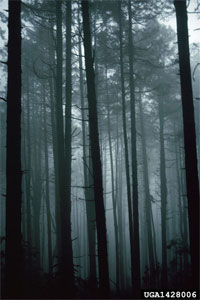|
Nutrients can enter an ecosystem through geological, hydrological and biological process.
Specifically the processes of mineral weathering, atmospheric deposition and biological fixation are the primary mechanisms which allow nutrients to be introduced into an ecosystem.
Mineral weathering is the process by which nutrients are released from the chemical structure of rocks and soil minerals through abrasion, and chemical dissolution.
This process is strongly influenced by the climate, temperature, and precipitation regimes.
All plant nutrients except nitrogen can be supplied to an ecosystem through mineral weathering.
Atmospheric deposition is the process of nutrients entering an ecosystem from the atmosphere (Barnes et al. 1998).
There are three processes which can contribute to atmospheric deposition: 1)
wet deposition 2) dry deposition and 3) cloud deposition.
Wet deposition occurs when nutrients are added to an ecosystem through rain or snow.
Dry deposition occurs when nutrients enter an ecosystem directly from the atmosphere to the soil, vegetation or water surfaces within that ecosystem.
Cloud deposition is the process of nutrients being deposited in an ecosystem from the non-precipitating water droplets found in clouds and fog.
Although wet and dry deposition occurs in all ecosystems their importance in terms of nutrient additions varies from place to place.
Cloud deposition typically occurs in coastal and mountainous regions where the vegetation is more likely to be exposed to low clouds or fog.

William M. Ciesla, Forest Health Management International, www.forestryimages.org
Inputs of nitrogen to forest ecosystems occur through the biological fixation caused by bacteria, lichens, and other free living organisms.
Other plants such as legumes can also fix nitrogen within an ecosystem.
Nitrogen fixing plants such as legumes can become abundant after disturbances such as fire.
In many ecosystems increased levels of nitrogen can dramatically increase biomass production, especially in soils which are nitrogen limited.
|
